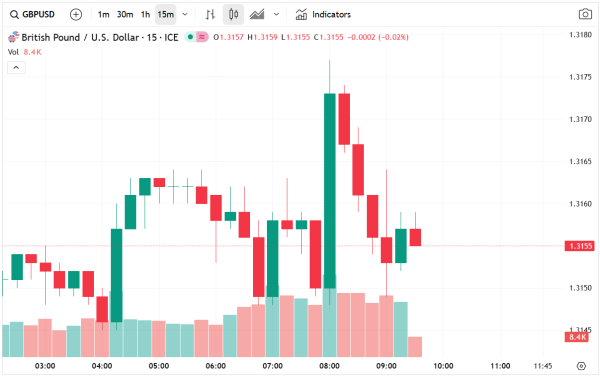The GBP/USD exchange rate remained flat on Tuesday morning, trading at 1.3160, as investors positioned themselves ahead of crucial UK consumer and producer inflation data. Sterling is currently down by over 4% from its September highs, reflecting market caution amid ongoing macroeconomic developments.
Analysts suggest that the pair could face renewed downside pressure, as technical indicators signal that the recent recovery may have stalled at key resistance levels. The LFtrade team presents a structured and informative breakdown of this matter.
UK Consumer and Producer Inflation Data Ahead
Market participants are closely monitoring the upcoming UK inflation numbers, including the Consumer Price Index (CPI), core CPI, and the Retail Price Index (RPI). Economists anticipate that the headline CPI will decline slightly, slipping from 3.8% in September to 3.6% in October, while core CPI is expected to ease from 3.5% to 3.4%. Meanwhile, the RPI is projected at 4.3%, down from 4.5%.
Despite these modest declines, headline inflation remains significantly above the Bank of England’s (BoE) 2% target, which may constrain the BoE’s ability to cut interest rates in the near term. Persistent inflationary pressures are likely to weigh on sterling sentiment, as traders remain cautious about the timing and scale of potential monetary policy adjustments.
Another important catalyst is the upcoming UK budget speech by Chancellor Rachel Reeves, scheduled for next week. While the official release is pending, market leaks have suggested that the Chancellor may avoid raising income tax, contrary to analysts’ expectations. Any such developments could influence GBP/USD trading in the short term, as investors react to fiscal policy signals and potential impacts on the UK economy.
US Economic Data and Fed Watch
Across the Atlantic, the Federal Reserve (Fed) will release minutes from its most recent FOMC meeting on Wednesday. These minutes are highly anticipated, as they provide insight into the discussions that led to the Fed’s second interest rate cut of the year. Market participants are particularly focused on the tone of the commentary regarding inflation, economic growth, and the possibility of further monetary easing.
Recent statements from some Fed officials have emphasized concerns about the risks of aggressive rate cuts, given that US inflation has remained above the 2% target for over four years. As a result, the probability of a December rate cut has fallen to below 50%, adding another layer of uncertainty to GBP/USD forecasts. This combination of UK inflation data and US monetary policy signals is expected to drive short-term volatility in the pair.

GBP/USD Technical Analysis: Bearish Bias Emerges
On the daily timeframe, GBP/USD has faced significant resistance over recent weeks. The current trading level of 1.3165 coincides with the 38.2% Fibonacci Retracement of the previous downtrend, a critical technical barrier that has historically acted as a reversal point.
Additionally, this level aligns with the August low, forming the neckline of a double-top pattern at 1.3718. The pair is also trading below the 50-day Exponential Moving Average (EMA), further reinforcing the bearish technical outlook. Traders observing these key indicators are likely to anticipate a resumption of the downtrend, potentially targeting the November low at 1.3010 as the next major support level.
Technical analysts highlight that any move above 1.3300 would invalidate the bearish outlook and signal a potential reversal or consolidation phase. Until such a breakout occurs, the probability favors continued sterling weakness against the US dollar.
Market Outlook and Trading Strategy
Given the combination of flat GBP/USD trading, elevated UK inflation readings, and cautious Fed commentary, the forex signal for traders leans toward a bearish bias. Short-term traders may consider monitoring the 1.3010 support level for potential entry points, while also keeping an eye on resistance at 1.3300 for any signs of upside breakout.

Fundamental factors such as consumer price inflation, producer price inflation, and fiscal policy announcements remain critical drivers of GBP/USD volatility. Meanwhile, technical factors, including the Fibonacci retracement, double-top pattern, and 50-day EMA, provide actionable signals for trend-following strategies.
Conclusion: Sterling Faces Resistance, Downside Potential Persists
In summary, the GBP/USD pair is consolidating near 1.3160, encountering resistance at a key technical level after a modest recovery. UK inflation data, Chancellor Reeves’ upcoming budget speech, and Fed minutes represent the next major catalysts that could influence the direction of sterling.
From a technical perspective, the pair remains below the 50-day EMA and near the 38.2% Fibonacci retracement, suggesting that the downtrend may resume, potentially testing 1.3010 support. Traders should remain alert to key economic releases and market reactions, as GBP/USD volatility could intensify in the coming sessions.










